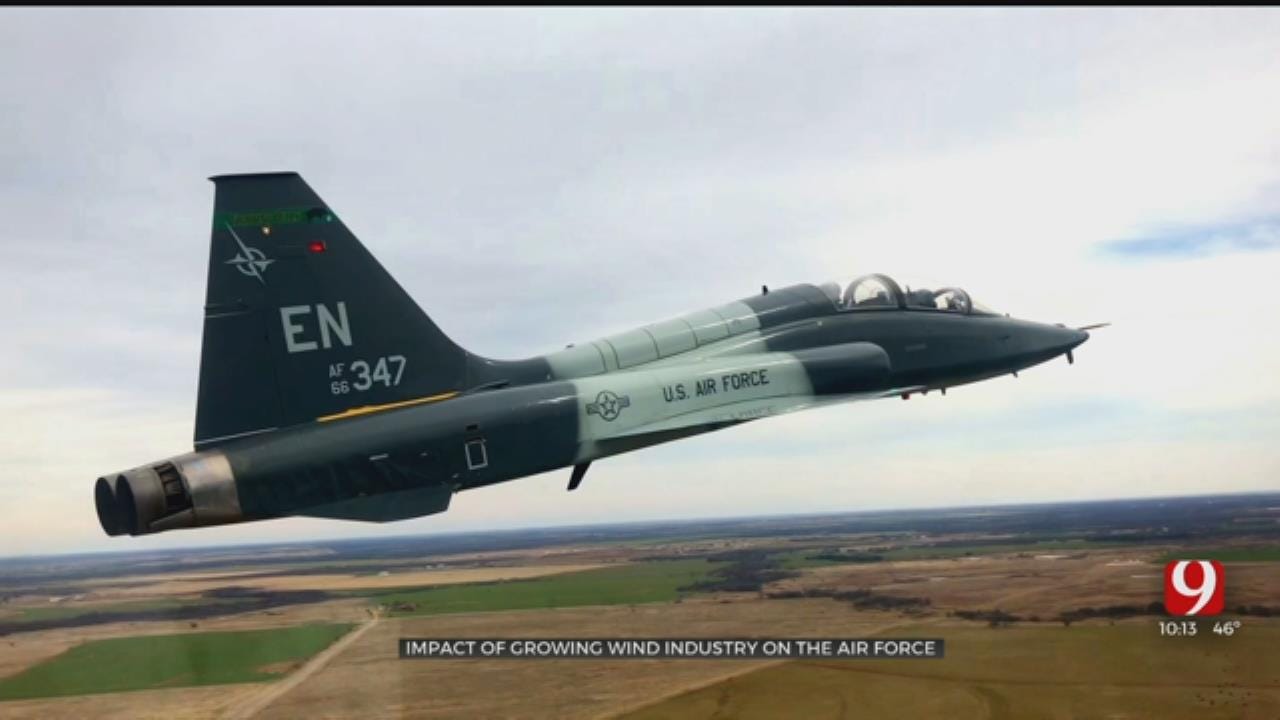9 Investigates: Impact Of Growing Wind Industry On The Air Force
Top brass at Sheppard Air Force Base, home to what they say is the premier jet fighter pilot training program in the country, look north into Oklahoma and have one request for companies developing new wind farms: "Just work with us." The plea comes as theThursday, May 9th 2019, 11:08 pm
Top brass at Sheppard Air Force Base, home to what they say is the premier jet fighter pilot training program in the country, look north into Oklahoma and have one request for companies developing new wind farms: "Just work with us."
The plea comes as the wind industry has taken off in Oklahoma -- now number two in the nation in wind energy generation -- and, as a result, has begun to encroach on valuable airspace.
"It's not just windfarms, it's towers, too -- anything vertical development," said Lt. Col. Joseph Gaona, Director of the 80th Flying Training Wing's Mission Sustainment Cell.
Lt. Col. Gaona says the reason that wind turbines and other vertical development in and along military training routes (MTRs) pose a serious concern is simple: "There's a lot of student drivers, if you will, out there."
The 'student drivers' are future fighter pilots, and not just for the United States, but also for our NATO allies. Since 1981, Sheppard Air Force Base has been home to the Euro-NATO Joint Jet Pilot Training Program (ENJJPT), using western Oklahoma airspace to prepare thousands of American and international pilots for combat.
"Our mandate is to generate fighter pilots here," said Lt. Col. Gaona, "who can navigate and fly at low levels safely."
For the Air Force, low level means 500 feet above ground level (AGL), which is just about the same height as the newer wind turbines. Obviously, pilots can steer their planes around turbines (training routes for Sheppard's faster training jet, the T-38, are about twenty miles wide), but having to do that too often, officials say, defeats the purpose of having designated training routes.
"If you took a corridor and you had a couple speed bumps in there," Lt. Col. Gaona explained, "it's like, alright, we can go around. But it's when it starts to stack more and more and more, then we're limited to a certain routing."
What's more, Gaona says, 'going around' may just take the plane into the path of another object.
"Well, where do we go? We just gotta go high," stated Gaona. "Well, if we gotta go high, we're not doing low level training anymore."
In an effort to better understand the negative impact of Oklahoma's wind industry on Sheppard's training program, and therefore the military devaluation of Oklahoma airspace, News 9 accepted an invitation to fly one of the training routes in a T-38 jet.
"All right, call sign -- we're gonna be Dozier 5-1," said Maj. Mike Sydney to begin our pre-flight briefing.
In early March, photographer Craig Gaglio and I made the drive south on I-44 just over the Texas border so that I could fly and Craig could document it all.
The day started with a medical screening and was followed by an hour of instruction on the use of the T-38's ejector seat, I then had to be schooled on how to properly buckle in, breathe, and put on a G-suit.
It was only after navigating my way through those tasks that I was introduced to Major Sydney, the 80 FTW's airspace manager and also an instructor pilot. And on this day, he would be my pilot.
Sitting in on the pre-flight briefing with us were two NATO instructor pilots who would be in another T-38 and joining us on our afternoon sortie. Major Sydney was thorough in reviewing the route we would be flying and all the obstacles in it.
"Several towers [here]," Sydney said, pointing to a spot in southern Oklahoma where the route turns. "2.0's gonna be our safe altitude -- if we don't see these guys, then we'll drop down, maybe for a little bit."
It was clear from the briefing that flying this particular MTR -- VR 1139 -- would allow for only limited periods of 'dropping down' to 500 feet. The goal, ENJJPT officials say, is to fly as much of the route as possible at low level.
"You can say that you can simulate [low level] in other ways, but unless you're close to the ground and kind of feeling that threat of death," said Lt. Col. Gaona, "it's not the same."
I was about to experience this feeling myself.
With the other T-38 on our wing, we flew in tactical formation, southeast from Sheppard's airfield to the entrance of VR 1139, one of six MTRs designated for T-38 low level operations. These routes are all about twenty miles wide.
VR 1139 runs from east of Wichita Falls north into Oklahoma and then northwest to around Hinton. Wind turbines were everywhere -- in Texas, as well as, in Oklahoma -- engendering frequent communication between planes.
"You got a tower off your nose," came the voice of the other plane's pilot, "I'm bracketing this tower off to your left."
Moments later, Maj. Sydney was pointing out another grouping of wind turbines to me: "We got a bunch of towers off our nose...so, for [them], unfortunately, we're just gonna have to climb for it, we can't go around it necessarily."
Earlier, at the conclusion of the pre-flight briefing, Maj Sydney had discussed the possibility of a bird strike and the potential scenarios -- some of them catastrophic -- that could result. He assured me this was highly unlikely, but that he was obligated to inform me that bird strikes are a risk along this route.
Now, flying along at 375 knots (431 mph) and having just ascended to 1,000 ft AGL, in order to clear more wind turbines, Sydney's voice crackled in my headset.
"Oh, lots of birds! Lots of birds!" he exclaimed.
We successfully avoided the birds, but barely twenty minutes into our flight, it was clear that navigating this training route, at jet fighter speeds, requires not only strong concentration and flying skills, but also a strong stomach.
Major Sydney says training young men and women to be fighter pilots is difficult enough without having to worry about the spread of wind farms.
"They put the program here because it was conducive to that kind of training," Maj. Sydney stated, "but it's starting to encroach on that -- on that objective."
Laid out on a map, it appears that roughly half of Sheppard's military training routes are in Oklahoma airspace. When existing wind farms are superimposed on the map, it's possible to see why three of the routes were shut down in recent years, and why VR 1139, the one we flew, is now rarely used.

"Now it's just completely covered with obstructions, so it really makes what we're doing hard," said Sydney, "just because we can't fly as low as we normally want to get the students more comfortable with that environment."
Between Sheppard's training mission and the pilot training at Oklahoma's Air Force bases, military advocates say Oklahoma's airspace is, not only the state's number one military asset, but a true national security asset.
"If you think about it, a third of all the pilots come from an Oklahoma base," said Mike Cooper, Chairman of the Oklahoma Strategic Military Planning Commission, "and then all the NATO pilots are being trained out of Sheppard."
Still, Cooper says Oklahoma's military supporters are not against wind energy.
"What we are against," Cooper said, "is taking away from our mission capability and eroding the footprint of our training space in Oklahoma."
To that end, Cooper and leaders at the Oklahoma Aeronautics Commission joined forces last year and successfully pushed through legislation restricting when and where wind developers could build new turbines. The law required wind developers to get either a determination of No Hazard from the Federal Aviation Administration or have an agreed-upon mitigation plan with the Department of Defense.
The wind industry was also consulted on the legislation, and representatives say they're on board.
"You don't want to encroach on these vital training routes," said Mark Yates. Vice President of Advanced Power Alliance, "and we want to be collaborative with the military, which we have been."
At least one wind developer, NextEra Energy, tested the new law.
In the summer of 2018, several months after the law had taken effect, NextEra commenced construction of wind turbines near Hinton. The company had not obtained the necessary federal approval, however, and following formal complaints filed both by the the Aeronautics Commission and Strategic Military Planning Commission, Oklahoma Attorney General Mike Hunter ordered the company to halt construction.
Subsequent efforts by NextEra to reach a mitigation agreement with the DoD, as mandated by AG Hunter, have yet to bear fruit, and portions of the Florida-based energy company's Minco IV & V wind farms remain on hold.
With the NextEra incident in mind, the same parties went back to Legislature this session to attempt to further tighten the wind farm siting law. And just this week, Governor Kevin Stitt signed HB 2118, which means wind developers will now have to get approval from both the FAA and the DoD before being allowed to move forward with construction of any new turbines. Proof of such approval must now be submitted to the Oklahoma Corporation Commission, as well as, to the Aeronautics Commission.
Air Force officials say pilot training and wind energy can co-exist -- they're just asking for cooperation.
"Give us the width, the breadth to let them make a couple mistakes,"
Pilots who can made mistakes safely in training, they say, are less likely to make mistakes when it counts, in combat.
More Like This
December 5th, 2019
October 17th, 2019
August 29th, 2019
Top Headlines
March 12th, 2025
March 12th, 2025













